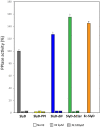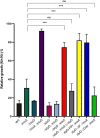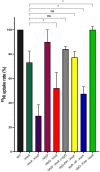A novel mode of control of nickel uptake by a multifunctional metallochaperone
- PMID: 33444370
- PMCID: PMC7840056
- DOI: 10.1371/journal.ppat.1009193
A novel mode of control of nickel uptake by a multifunctional metallochaperone
Abstract
Cellular metal homeostasis is a critical process for all organisms, requiring tight regulation. In the major pathogen Helicobacter pylori, the acquisition of nickel is an essential virulence determinant as this metal is a cofactor for the acid-resistance enzyme, urease. Nickel uptake relies on the NixA permease and the NiuBDE ABC transporter. Till now, bacterial metal transporters were reported to be controlled at their transcriptional level. Here we uncovered post-translational regulation of the essential Niu transporter in H. pylori. Indeed, we demonstrate that SlyD, a protein combining peptidyl-prolyl isomerase (PPIase), chaperone, and metal-binding properties, is required for the activity of the Niu transporter. Using two-hybrid assays, we found that SlyD directly interacts with the NiuD permease subunit and identified a motif critical for this contact. Mutants of the different SlyD functional domains were constructed and used to perform in vitro PPIase activity assays and four different in vivo tests measuring nickel intracellular accumulation or transport in H. pylori. In vitro, SlyD PPIase activity is down-regulated by nickel, independently of its C-terminal region reported to bind metals. In vivo, a role of SlyD PPIase function was only revealed upon exposure to high nickel concentrations. Most importantly, the IF chaperone domain of SlyD was shown to be mandatory for Niu activation under all in vivo conditions. These data suggest that SlyD is required for the active functional conformation of the Niu permease and regulates its activity through a novel mechanism implying direct protein interaction, thereby acting as a gatekeeper of nickel uptake. Finally, in agreement with a central role of SlyD, this protein is essential for the colonization of the mouse model by H. pylori.
Conflict of interest statement
The authors have declared that no competing interests exist. Author Deborah Zamble was unable to confirm their authorship contributions. On their behalf, the corresponding author has reported their contributions to the best of their knowledge.
Figures










Similar articles
-
Characterization in Helicobacter pylori of a Nickel Transporter Essential for Colonization That Was Acquired during Evolution by Gastric Helicobacter Species.PLoS Pathog. 2016 Dec 6;12(12):e1006018. doi: 10.1371/journal.ppat.1006018. eCollection 2016 Dec. PLoS Pathog. 2016. PMID: 27923069 Free PMC article.
-
Nickel binding and [NiFe]-hydrogenase maturation by the metallochaperone SlyD with a single metal-binding site in Escherichia coli.J Mol Biol. 2012 Mar 16;417(1-2):28-35. doi: 10.1016/j.jmb.2012.01.037. Epub 2012 Jan 30. J Mol Biol. 2012. PMID: 22310044
-
Nickel, an essential virulence determinant of Helicobacter pylori: Transport and trafficking pathways and their targeting by bismuth.Adv Microb Physiol. 2022;80:1-33. doi: 10.1016/bs.ampbs.2022.01.001. Epub 2022 Feb 18. Adv Microb Physiol. 2022. PMID: 35489790 Review.
-
Evolution of Helicobacter: Acquisition by Gastric Species of Two Histidine-Rich Proteins Essential for Colonization.PLoS Pathog. 2015 Dec 7;11(12):e1005312. doi: 10.1371/journal.ppat.1005312. eCollection 2015 Dec. PLoS Pathog. 2015. PMID: 26641249 Free PMC article.
-
Molecular function of the prolyl cis/trans isomerase and metallochaperone SlyD.Biol Chem. 2013 Aug;394(8):965-75. doi: 10.1515/hsz-2013-0137. Biol Chem. 2013. PMID: 23585180 Review.
Cited by
-
Bacterial Membrane Vesicles as a Novel Strategy for Extrusion of Antimicrobial Bismuth Drug in Helicobacter pylori.mBio. 2022 Oct 26;13(5):e0163322. doi: 10.1128/mbio.01633-22. Epub 2022 Sep 26. mBio. 2022. PMID: 36154274 Free PMC article.
-
The structure of the high-affinity nickel-binding site in the Ni,Zn-HypA•UreE2 complex.Metallomics. 2023 Mar 6;15(3):mfad003. doi: 10.1093/mtomcs/mfad003. Metallomics. 2023. PMID: 36638839 Free PMC article.
-
Positive charges promote the recognition of proteins by the chaperone SlyD from Escherichia coli.PLoS One. 2024 Jun 25;19(6):e0305823. doi: 10.1371/journal.pone.0305823. eCollection 2024. PLoS One. 2024. PMID: 38917203 Free PMC article.
-
The Effects of Vitamins and Micronutrients on Helicobacter pylori Pathogenicity, Survival, and Eradication: A Crosstalk between Micronutrients and Immune System.J Immunol Res. 2022 Mar 16;2022:4713684. doi: 10.1155/2022/4713684. eCollection 2022. J Immunol Res. 2022. PMID: 35340586 Free PMC article. Review.
References
Publication types
MeSH terms
Substances
Grants and funding
LinkOut - more resources
Full Text Sources
Other Literature Sources
Medical
Molecular Biology Databases
Miscellaneous

